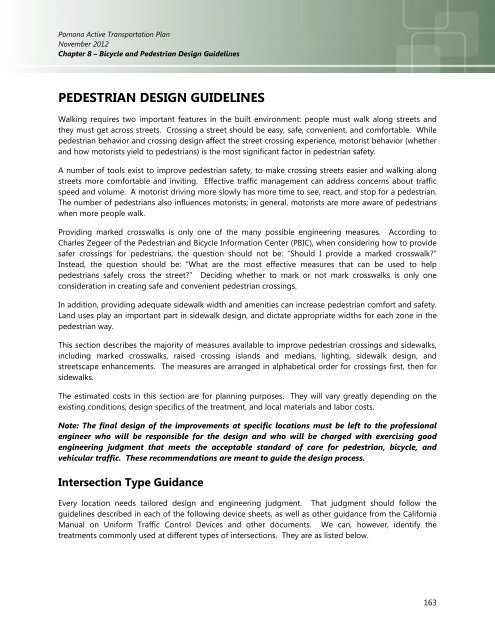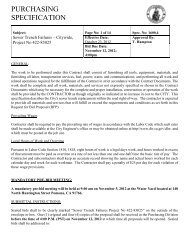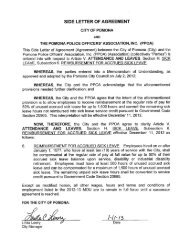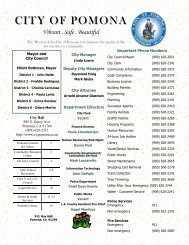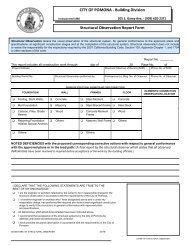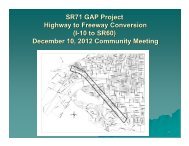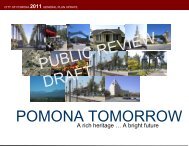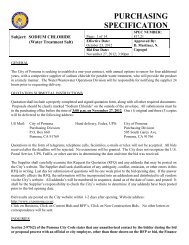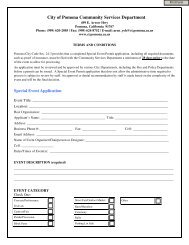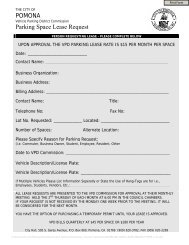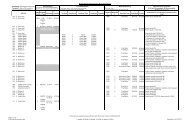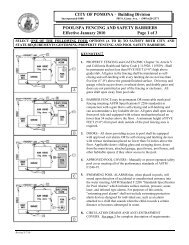Active Transportation Plan - City of Pomona
Active Transportation Plan - City of Pomona
Active Transportation Plan - City of Pomona
Create successful ePaper yourself
Turn your PDF publications into a flip-book with our unique Google optimized e-Paper software.
<strong>Pomona</strong> <strong>Active</strong> <strong>Transportation</strong> <strong>Plan</strong><br />
November 2012<br />
Chapter 8 – Bicycle and Pedestrian Design Guidelines<br />
PEDESTRIAN DESIGN GUIDELINES<br />
Walking requires two important features in the built environment: people must walk along streets and<br />
they must get across streets. Crossing a street should be easy, safe, convenient, and comfortable. While<br />
pedestrian behavior and crossing design affect the street crossing experience, motorist behavior (whether<br />
and how motorists yield to pedestrians) is the most significant factor in pedestrian safety.<br />
A number <strong>of</strong> tools exist to improve pedestrian safety, to make crossing streets easier and walking along<br />
streets more comfortable and inviting. Effective traffic management can address concerns about traffic<br />
speed and volume. A motorist driving more slowly has more time to see, react, and stop for a pedestrian.<br />
The number <strong>of</strong> pedestrians also influences motorists; in general, motorists are more aware <strong>of</strong> pedestrians<br />
when more people walk.<br />
Providing marked crosswalks is only one <strong>of</strong> the many possible engineering measures. According to<br />
Charles Zegeer <strong>of</strong> the Pedestrian and Bicycle Information Center (PBIC), when considering how to provide<br />
safer crossings for pedestrians, the question should not be: “Should I provide a marked crosswalk”<br />
Instead, the question should be: “What are the most effective measures that can be used to help<br />
pedestrians safely cross the street” Deciding whether to mark or not mark crosswalks is only one<br />
consideration in creating safe and convenient pedestrian crossings.<br />
In addition, providing adequate sidewalk width and amenities can increase pedestrian comfort and safety.<br />
Land uses play an important part in sidewalk design, and dictate appropriate widths for each zone in the<br />
pedestrian way.<br />
This section describes the majority <strong>of</strong> measures available to improve pedestrian crossings and sidewalks,<br />
including marked crosswalks, raised crossing islands and medians, lighting, sidewalk design, and<br />
streetscape enhancements. The measures are arranged in alphabetical order for crossings first, then for<br />
sidewalks.<br />
The estimated costs in this section are for planning purposes. They will vary greatly depending on the<br />
existing conditions, design specifics <strong>of</strong> the treatment, and local materials and labor costs.<br />
Note: The final design <strong>of</strong> the improvements at specific locations must be left to the pr<strong>of</strong>essional<br />
engineer who will be responsible for the design and who will be charged with exercising good<br />
engineering judgment that meets the acceptable standard <strong>of</strong> care for pedestrian, bicycle, and<br />
vehicular traffic. These recommendations are meant to guide the design process.<br />
Intersection Type Guidance<br />
Every location needs tailored design and engineering judgment. That judgment should follow the<br />
guidelines described in each <strong>of</strong> the following device sheets, as well as other guidance from the California<br />
Manual on Uniform Traffic Control Devices and other documents. We can, however, identify the<br />
treatments commonly used at different types <strong>of</strong> intersections. They are as listed below.<br />
163


